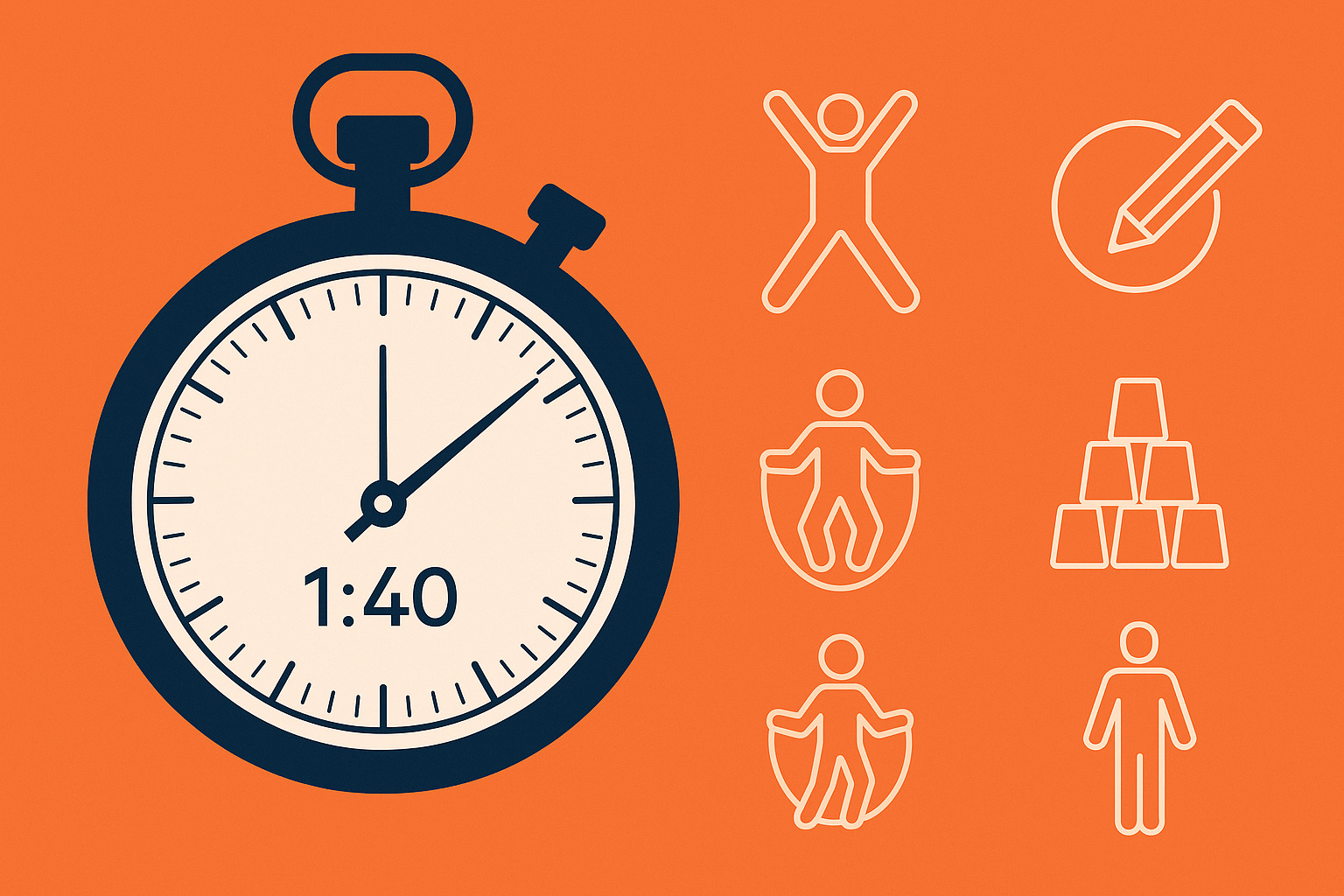100 seconds. One minute and 40 seconds. Just enough time to brew a cup of coffee, scroll through a few posts—or push yourself to the limit in ways you hadn’t imagined. The 100 seconds challenge isn’t tied to a single activity or skill. It’s an open-ended concept built around a simple question: How much can you accomplish in 100 seconds?
Used in classrooms, gyms, living rooms, and even online games, this short, punchy challenge framework turns everyday tasks into tests of endurance, creativity, and focus.
Why 100 Seconds Works
Time constraints create urgency. 100 seconds is short enough to prevent overthinking but long enough to push boundaries. Whether you’re training muscles, testing memory, or building structures, the countdown keeps things exciting and measurable.
Educational 100 Seconds Challenges
These are go-to picks for teachers looking to inject speed-based fun into learning environments. Ideal for the 100th Day of School or any classroom break.
Try These in the Classroom:
- Write as many numbers as possible: Start from 1 and write continuously. See who reaches the highest count.
- Repeat your name: Fill the paper with as many iterations of your name as you can squeeze in.
- List known words: Vocabulary sprint. Every real word counts.
- Adjective storm: Fill the page with descriptive words—fast.
- Multiplication memory: Recite or write as many multiplication facts as possible, focusing on tricky tables like 6, 7, and 8.
These tasks sharpen focus and reinforce repetition, all while tapping into students’ natural drive to outperform their last score.
Physical Activities for 100 Seconds
For kids and adults alike, 100 seconds of motion can reveal a lot about strength, balance, and endurance.
Examples of Physical Challenges:
- Star jumps: Count each jump. Don’t slow down.
- Blinking challenge: Oddly exhausting—and hilarious to watch.
- Squats: Quads will feel it after 60 seconds.
- One-foot hops: Test balance and stamina.
- Claps: Fast hands win.
- Push-ups: Full extension or modified; form matters.
- Toe touches: How many stretches before the buzzer?
- Netball or basketball bounces: Coordination under pressure.
- Cone dribbling: Requires setup but fun in groups.
- Side twists: Core meets cardio.
- Freeze frame: Stand perfectly still—easier said than done.
These physical drills don’t need special equipment. Most can be done at home or in a school gym.
Creative and Construction-Based Tasks
Not every challenge requires sweat. Some reward a calm mind and fast fingers.
Creative Options:
- Draw circles: Not doodles—just clean, consistent circles. Speed meets control.
- Build a tall tower: Use paper cups, marshmallows, or toy bricks. Gravity is the only enemy.
- Stack marshmallows: Sticky, soft, and unpredictable. Precision matters.
- Construct something from 100 items: Strips of paper, plastic cups, wooden blocks—whatever you have on hand.
- Puzzle rush: Start a 100-piece jigsaw. How many pieces can you place before time runs out?
These activities work well in team settings, especially with kids. They’re also great for parties and team-building exercises.
Fitness Skill Tests
Many of the physical activities double as light fitness tests. But some challenges directly test a specific skill or motion under pressure.
Go-To Fitness Skill Challenges:
- Jump rope: Precision and rhythm are key. Miss a jump and time keeps moving.
- Sit-ups: Count each rep. Keep form tight.
- Shadow boxing: Throw combos nonstop.
- Wall sits: How long can you stay locked in before your legs beg for mercy?
- High knees: Fast footwork without losing steam.
100 seconds doesn’t seem long—until you’re halfway through and everything burns.
Online & Game-Based Challenges
Some challenges need nothing but a browser and a bit of brainpower.
Popular Game-Based Challenges:
- Trivia blitz: Answer 10 questions in under 100 seconds. One wrong move? Start again.
- Typing tests: Speed + accuracy = score. Typos kill time.
- Memory flips: Flip and match pairs before the clock runs out.
- Math races: Quick-fire equations against the countdown.
- Pattern puzzles: Spot sequences and complete them fast.
These are great warm-ups before classes or meetings and fit naturally into online learning or remote team activities.
Minute to Win It–Style Adaptations
Many household tasks can be turned into low-prep, high-energy competitions.
Try These Crowd-Pleasers:
- Move a cookie from forehead to mouth without using hands.
- Stack apples or dice using one hand only.
- Transfer cotton balls using a spoon held in your mouth.
- Blow up balloons and knock over cups.
- Stack coins or buttons with chopsticks.
These games test fine motor skills and often spark more laughter than competition. Great for parties, family nights, and camps.
Self-Reflection Element
A valuable twist to the 100 seconds challenge is prediction. Before each round, participants estimate their outcome. Afterward, they compare guesses to actual performance. This simple step builds awareness, goal-setting habits, and self-assessment skills.
Over time, tracking these results can show patterns in stamina, focus, or progress—without the need for elaborate tests or tech.
Challenge Ideas by Setting
For the Classroom:
- Write synonyms for “happy”
- List animals or countries
- Spell as many words from a theme (e.g., food)
- Count backward from 500
For the Gym:
- Punching bag combos
- Kettlebell swings
- Stair climbs
- Bear crawls
For Home or Parties:
- Sock toss into a basket
- Paper plane distance throws
- Cup stacking
- Speed sorting (e.g., colored beads or cards)
Final Thoughts
The 100 seconds challenge isn’t about winning. It’s about discovering what can happen in a short, focused burst of effort. With only 1:40 on the clock, each second matters. Each task builds focus, self-awareness, and energy—whether you’re in a classroom, living room, gym, or Zoom call.
Try one challenge today. Then beat your score tomorrow.






